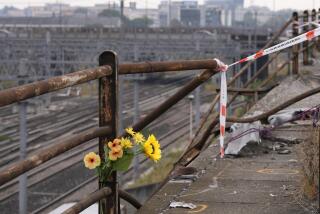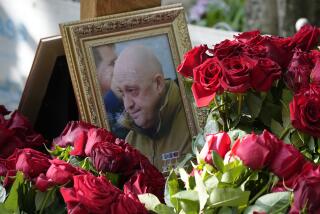ITALY : Air Crash Puzzle May Be Solved
ROME — At 8:57 p.m. on June 27, 1980, a DC-9 jetliner in level and routine flight between Bologna and Palermo exploded without warning and crashed into the Tyrrhenian Sea near the island of Ustica. All 81 people aboard died.
What happened? Government investigators couldn’t decide if a bomb or a missile destroyed the plane, but most of the evidence suggested that the airliner was shot down by a warplane.
Whose? After nearly 12 years, countless investigations and endless conspiracy theories, noone can say--or at least will say--for sure. Greater or lesser speculation--every major Italian newspaper seems to have its own pet theory--has variously focused on Italy, the United States, France or Libya.
Now, Roman Magistrate Rosario Priore and parliamentary investigators may at last be moving toward a solution to the lingering Ustica mystery.
Weighing old and new evidence, they complain of “deviations” and “silences” in official accounts of the crash.
Priore has formally warned 12 retired Italian air force officers and one still on active duty--nine of them generals--that he suspects them of directing an elaborate cover-up.
For years the air force dismissed speculation that a missile had struck the plane, first blaming the crash on a structural failure of the DC-9 and later on a bomb. It took years to dredge up key pieces of wreckage.
Air force documents, recordings of conversations and radar tapes were destroyed at the time or have been tampered with since, investigators say. Although there has long been published speculation that the air force hid and manipulated the facts, there has never been a formal accusation.
Priore leveled an official finger at the 13 officers after two trips to the United States in which he conferred with American military officers. He has not said what he learned or whether he believes that he knows the cause of the crash.
Italian newspapers, however, say Priore understands that air force officials informed the U.S. Embassy in Rome of the crash even before telling the Italian government, perhaps initially assuming a collision between the passenger plane and an American military aircraft.
The DC-9 belonging to the now-defunct airline Itavia fell from a busy, strategic and closely watched piece of sky off southern Italy. There had been American military activity in the area that day, and a French aircraft carrier was also in the vicinity.
By far the favorite theory over the years has been that the DC-9 was mistakenly downed by a French or American carrier-based fighter. But the United States, France and NATO all emphatically deny any role in the incident.
A possible Libyan connection has been bruited about since the discovery, a few weeks after the Itavia crash, of the wreckage of a Libyan jet fighter in a mountainous region on the southern Italian mainland.
Did the jet pilot mistakenly shoot down the plane? Or was he a defector who died trying to flee? Perhaps a pursuing Libyan fired at him and hit the airliner instead?
The Rome newspaper La Repubblica, which subscribes to the Libya theory, speculated recently that the Libyan warplane had deliberately or mistakenly entered Italian airspace while attempting to monitor a French airlift to aid army units in Chad. Chad’s army was fighting rebels supported by Libyan leader Moammar Kadafi.
A French jet fired at the Libyan warplane, the newspaper theorizes, but hit the airliner. One problem with the possible Libyan link is that investigators have not been able to determine precisely when the fighter crashed: It may have gone down before the airliner did.
Defense Minister Virginio Rognoni promises Senate investigators that the lame-duck government of Prime Minister Giulio Andreotti, which faces national elections April 6, will cooperate with the current inquiries.
But Rognoni has refused to suspend Gen. Zeno Tascio, the only one of the 13 officers still on active duty. To the consternation of families of the crash victims, neither will the government press formal charges against the 13 until the judicial and Senate inquiries are complete.
“The government’s decision amazes and embitters us deeply,” said a statement by lawyers for the victims’ relatives. “We have lost a good chance to give the country a clear and unequivocal signal of determination to stop at nothing to find the truth.”
Over the years, “Ustica” has become Italian shorthand for a scandal that taints the government. It is one of at least seven acts of mass destruction and innumerable Mafia and political murders in Italy over the last two decades in which major investigations have borne scant fruit.
“In Italy, there is no justice when it comes to massacres or major political and Mafia crimes,” complained the Milan newspaper L’Indipendente.
More to Read
Sign up for Essential California
The most important California stories and recommendations in your inbox every morning.
You may occasionally receive promotional content from the Los Angeles Times.










